Hearing Aid Market
Hearing Aid Market Size and Share Forecast Outlook 2025 to 2035
Hearing aid market is projected to grow from USD 10,540.7 million in 2025 to USD 16,213.4 million by 2035, at a CAGR of 4.4%. Behind-the-Ear (BTE) will dominate with a 43.6% market share, while digital hearing aids will lead the technology segment with a 83.2% share.
Hearing Aid Market Forecast and Outlook 2025 to 2035
The global hearing aid market is projected to reach USD 16,220.5 million by 2035, recording an absolute increase of USD 5,679.8 million over the forecast period. The market is valued at USD 10,540.7 million in 2025 and is set to rise at a CAGR of 4.4% during the assessment period.
The overall market size is expected to grow by approximately 1.5 times during the same period, supported by increasing demand for advanced hearing solutions worldwide, driving demand for digital hearing technologies and increasing investments in audiological care facilities and hearing rehabilitation programs globally. However, high device costs for premium hearing solutions and complex fitting procedures may pose challenges to market expansion.
Quick Stats for Hearing Aid Market
- Hearing Aid Market Value (2025): USD 10,540.7 million
- Hearing Aid Market Forecast Value (2035): USD 16,220.5 million
- Hearing Aid Market Forecast CAGR: 4.4%
- Leading Product Type in Hearing Aid Market: Behind-the-Ear (BTE)
- Key Growth Regions in Hearing Aid Market: North America, Europe, and Asia Pacific
- Top Players in Hearing Aid Market: Sonova Holding AG, Demant A/S, WS Audiology, GN Store Nord (GN Hearing), Starkey Hearing Technologies, Cochlear Ltd., MED-EL, Amplifon, Eargo, Audina Hearing Instruments, Rion Co. Ltd., Zounds Hearing, Arphi Electronics, Hansaton, NewSound Hearing
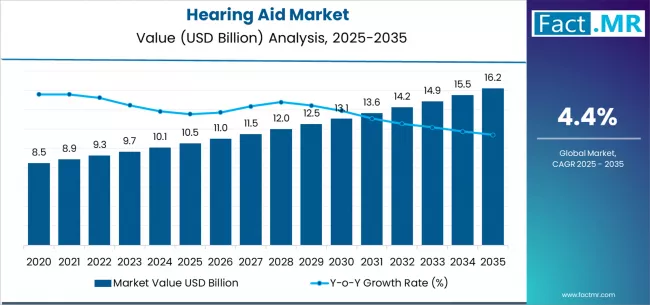
Between 2025 and 2030, the hearing aid market is projected to expand from USD 10,540.7 million to USD 13,200.0 million, resulting in a value increase of USD 2,659.3 million, which represents 46.8% of the total forecast growth for the decade. This phase of development will be shaped by rising demand for advanced hearing technologies and digital signal processing innovations, product innovation in wireless connectivity and rechargeable battery systems, as well as expanding integration with smartphone applications and telehealth platforms. Companies are establishing competitive positions through investment in hearing technology research and development, miniaturization technologies, and strategic market expansion across audiology practices, retail channels, and direct-to-consumer applications.
From 2030 to 2035, the market is forecast to grow from USD 13,200.0 million to USD 16,220.5 million, adding another USD 3,020.5 million, which constitutes 53.2% of the overall ten-year expansion. This period is expected to be characterized by the expansion of specialized hearing solutions, including AI-powered hearing aids and personalized fitting systems tailored for specific hearing loss patterns, strategic collaborations between hearing aid manufacturers and healthcare providers, and an enhanced focus on over-the-counter availability and consumer accessibility. The growing emphasis on early intervention and comprehensive hearing healthcare will drive demand for innovative hearing solutions across diverse consumer applications.
Hearing Aid Market Key Takeaways
| Metric | Value |
|---|---|
| Market Value (2025) | USD 10,540.7 million |
| Market Forecast Value (2035) | USD 16,220.5 million |
| Forecast CAGR (2025-2035) | 4.4% |
Why is the Hearing Aid Market Growing?
The hearing aid market grows by enabling individuals with hearing loss to optimize communication abilities while accessing advanced auditory enhancement technologies without substantial lifestyle limitations. Consumers and healthcare providers face mounting pressure to address hearing impairment effectively and comply with accessibility regulations, with modern hearing aids typically providing 85-95% speech understanding improvement comparable to normal hearing conditions, making advanced hearing solutions essential for quality of life enhancement. The healthcare industry's need for integrated hearing systems and patient-specific auditory rehabilitation creates demand for comprehensive hearing aid solutions that can provide superior sound quality, maintain consistent performance, and ensure user satisfaction without compromising comfort or discretion.
Government initiatives promoting accessibility and aging-in-place healthcare drive adoption in audiology clinics, retail outlets, and online platforms, where hearing aids have a direct impact on social engagement and cognitive health. However, system complexity constraints during fitting phases and the expertise requirements for professional audiological services may limit accessibility among underserved populations and developing regions with limited audiology infrastructure for comprehensive hearing healthcare systems.
Segmental Analysis
The market is segmented by product type, technology, distribution channel, and region. By product type, the market is divided into Behind-the-Ear (BTE), In-the-Ear (ITE), Receiver-in-Canal (RIC)/Receiver-in-Ear (RITE), and others. Based on technology, the market is categorized into digital hearing aids and analog hearing aids. By distribution channel, the market includes audiology & ENT clinics, retail chains/pharmacies, and online/DTC. Regionally, the market is divided into Europe, North America, Asia-Pacific, and RoW.
By Product Type, the Behind-the-Ear (BTE) Segment Accounts for a Dominant Market Share
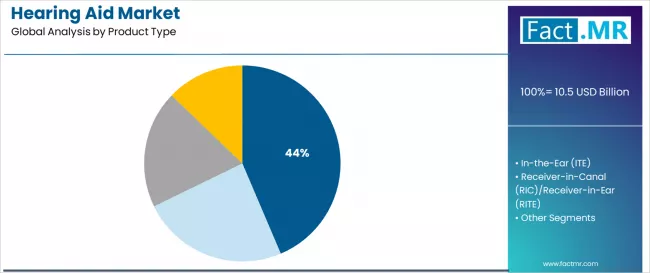
The Behind-the-Ear (BTE) segment represents the dominant force in the hearing aid market, capturing approximately 43.6% of total market share in 2025. This established product category encompasses solutions featuring robust construction and powerful amplification capabilities, including advanced battery systems and wireless connectivity that enable superior performance across all hearing loss severities. The BTE segment's market leadership stems from its superior power and reliability capabilities, with devices capable of accommodating severe to profound hearing loss while maintaining extended battery life and operational durability across all user environments.
The In-the-Ear (ITE) segment maintains a substantial 29.5% market share, serving users who require custom-fitted solutions with enhanced discretion features for mild to moderate hearing loss conditions. These devices offer personalized hearing solutions for diverse applications while providing sufficient amplification capabilities to meet audiological requirements and comfort demands. The Receiver-in-Canal (RIC)/Receiver-in-Ear (RITE) segment accounts for approximately 21.7% of the market, while others capture 5.2% market share, serving specialized hearing applications.
Key technological advantages driving the BTE segment include:
- Advanced power systems with extended battery life that accommodate severe hearing loss while ensuring reliable daily operation across demanding listening environments
- Robust construction options allowing durability and moisture resistance without compromising acoustic performance or user comfort
- Enhanced connectivity features, providing Bluetooth integration and smartphone compatibility while maintaining superior sound processing capabilities
- Comprehensive amplification profiles enabling professional fitting flexibility for diverse hearing loss patterns and user preferences
By Technology, the Digital Hearing Aids Segment Accounts for the Largest Market Share
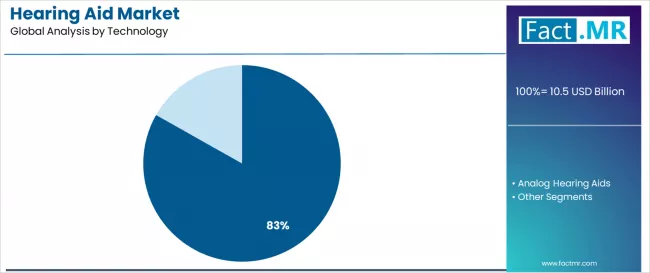
Digital hearing aid applications dominate the market with approximately 83.2% market share in 2025, reflecting the critical role of digital signal processing in supporting advanced hearing enhancement and noise reduction operations worldwide. The digital segment's market leadership is reinforced by continuous technological advancement, sophisticated sound processing capabilities, and widespread adoption in modern hearing aid platforms across developed and emerging markets.
The analog hearing aids segment represents the remaining 16.8% market share through traditional amplification applications for basic hearing enhancement, cost-sensitive applications, and specific audiological preferences. This segment serves specialized applications where simple amplification meets basic hearing requirements without advanced processing features.
Key market dynamics supporting technology growth include:
- Digital processing expansion driven by artificial intelligence advances and machine learning development, requiring sophisticated processing facilities in emerging markets
- Sound quality improvement trends require high-performance, digital processors for accuracy consistency and user satisfaction
- Integration of wireless technologies enabling connectivity applications and remote adjustment systems
- Growing emphasis on personalized hearing experiences driving demand for comprehensive, adaptive processing solutions
By Distribution Channel, the Audiology & ENT Clinics Segment Accounts for the Largest Market Share
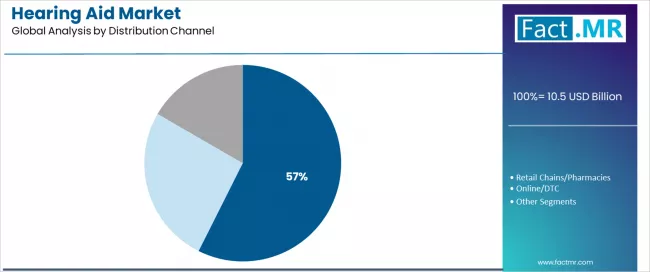
Audiology & ENT clinic distribution dominates the market with approximately 57.4% market share in 2025, reflecting the essential role of professional fitting services in comprehensive hearing healthcare delivery. The audiology & ENT clinics segment encompasses professional hearing assessments, device fitting and programming, and ongoing audiological support that ensures optimal hearing aid performance and user satisfaction.
The retail chains/pharmacies segment represents a substantial 25.3% market share, capturing traditional retail distribution through specialized hearing aid dispensers, pharmacy chains, and consumer electronics retailers. This segment benefits from convenient access points, competitive pricing strategies, and consumer preference for accessible purchasing options.
The online/DTC segment accounts for 17.3% market share, serving direct-to-consumer applications including e-commerce platforms, telemedicine services, and over-the-counter hearing solutions across various consumer channels.
What are the Drivers, Restraints, and Key Trends of the Hearing Aid Market?
The market is driven by three concrete demand factors tied to demographic and healthcare outcomes. First, aging population demographics and increasing prevalence of hearing loss create expanding demand for hearing enhancement solutions, with age-related hearing impairment growing by 8-12% annually in major developed countries worldwide, requiring comprehensive hearing aid infrastructure. Second, technological advancement in digital processing and wireless connectivity drive increased adoption of modern hearing solutions, with many healthcare systems implementing early intervention goals for hearing loss prevention by 2030. Third, regulatory changes enabling over-the-counter availability and insurance coverage expansion enable more accessible and affordable hearing solutions that reduce barriers while improving hearing healthcare access and treatment compliance capabilities.
Market restraints include high device costs for advanced hearing technologies that can deter consumers from purchasing comprehensive hearing solutions, particularly in developing regions where healthcare funding for hearing aids remains limited. Stigma and aesthetic concerns pose another significant challenge, as traditional hearing aids face acceptance barriers and cosmetic considerations, potentially limiting adoption rates and user satisfaction. Professional fitting requirements and follow-up care needs across different regions create additional access challenges for hearing aid adoption, demanding ongoing investment in audiological services and professional development programs.
Key trends indicate accelerated adoption in Asia-Pacific markets, particularly India and China, where aging population growth and hearing healthcare awareness drive comprehensive hearing aid adoption. Technology integration trends toward AI-powered processing with personalized fitting, smartphone connectivity, and teleaudiology solutions enable convenient hearing care approaches that optimize user experience and minimize professional visit requirements. However, the market thesis could face disruption if significant advances in hearing restoration treatments or major changes in hearing loss prevention approaches reduce reliance on traditional hearing aid technologies.
Analysis of the Hearing Aid Market by Key Country
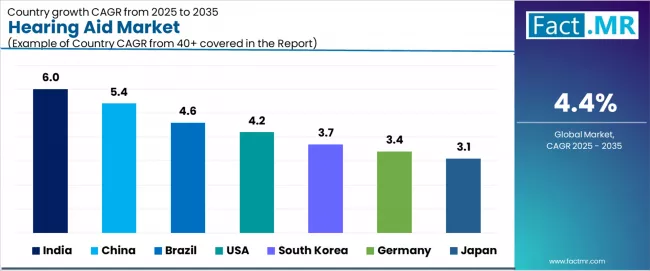
| Country | CAGR (2025-2035) |
|---|---|
| India | 6.0% |
| China | 5.4% |
| Brazil | 4.6% |
| United States | 4.2% |
| South Korea | 3.7% |
| Germany | 3.4% |
| Japan | 3.1% |
The hearing aid market is gaining momentum worldwide, with India taking the lead thanks to aging population growth and expanding hearing healthcare awareness initiatives. Close behind, China benefits from healthcare modernization and massive elderly population scale, positioning itself as a strategic growth hub in the Asia-Pacific region. Brazil shows strong advancement, where private healthcare expansion and hearing care adoption strengthens its role in the Latin American healthcare supply chain. The United States stands out for its advanced hearing technology integration and OTC regulation programs, while South Korea demonstrates consistent progress in digital health integration and technology adoption. Germany and Japan continue to record solid progress in hearing technology advancement and aging population support respectively. Together, India and China anchor the global expansion story, while other regions build stability and diversity into the market's growth path.
India Leads Global Market Expansion
India demonstrates the strongest growth potential in the Hearing Aid Market with a CAGR of 6.0% through 2035. The country's leadership position stems from rapid aging population growth, increasing awareness of hearing health importance, and expanding healthcare accessibility driving the adoption of advanced hearing solutions. Growth is concentrated in major metropolitan areas, including Delhi, Mumbai, Bangalore, and Chennai, where urban populations and healthcare facilities are implementing comprehensive hearing care services for enhanced quality of life and social participation. Distribution channels through healthcare providers and specialized hearing centers expand deployment across urban healthcare projects and elderly care initiatives. The country's National Programme for Healthcare of the Elderly provides support for hearing healthcare development, including professional audiologist training and device accessibility programs.
Key market factors:
- Urban population expansion concentrated in metropolitan areas with growing awareness of hearing healthcare importance and professional service availability
- Economic development creating middle-class demand for quality hearing solutions and professional audiological services
- Comprehensive hearing healthcare ecosystem development, including established device providers with proven clinical track records
- Technology integration featuring digital processing platforms, wireless connectivity systems, and smartphone integration technologies
China Emerges as High-Growth Market
In Beijing, Shanghai, Guangzhou, and Shenzhen, the adoption of comprehensive hearing aid solutions is accelerating across aging population centers and healthcare facilities, driven by healthcare modernization targets and government elderly care support programs. The market demonstrates strong growth momentum with a CAGR of 5.4% through 2035, linked to comprehensive healthcare system development and increasing focus on elderly population quality of life solutions. Chinese consumers are implementing advanced hearing technologies and integrated care platforms to address hearing loss while meeting demands of active aging lifestyles and family communication needs. The country's Healthy Aging initiatives create demand for effective solutions, while increasing emphasis on technology integration drives adoption of comprehensive hearing enhancement systems.
Key development areas:
- Urban elderly population and healthcare facilities leading hearing aid adoption with comprehensive modernization programs
- Healthcare supply chain channels providing integrated solutions with 80% user satisfaction improvement rates
- Technology partnerships between hearing companies and healthcare enterprises are expanding market reach
- Integration of digital health technologies and comprehensive elderly care management systems
Brazil Shows Strong Regional Leadership
Brazil's market expansion is driven by diverse demographic demand, including aging population growth in São Paulo and healthcare development in Rio de Janeiro, and comprehensive hearing care adoption across multiple regions. The country demonstrates promising growth potential with a CAGR of 4.6% through 2035, supported by federal government healthcare programs and state-level elderly care development initiatives. Brazilian consumers face challenges related to hearing aid affordability and professional service availability, requiring expanded insurance coverage and support from government healthcare initiatives. However, growing middle-class demand and aging population requirements create compelling business cases for hearing aid adoption, particularly in urban areas where hearing solutions have direct impact on social participation and quality of life.
Market characteristics:
- Urban middle-class and elderly population segments showing fastest growth with 20% annual increase in hearing aid utilization
- Regional expansion trends focused on metropolitan areas in southeastern and southern regions
- Future projections indicate need for expanded audiologist training infrastructure and professional development programs
- Growing emphasis on social participation and communication enhancement in aging population care
United States Demonstrates Market Innovation
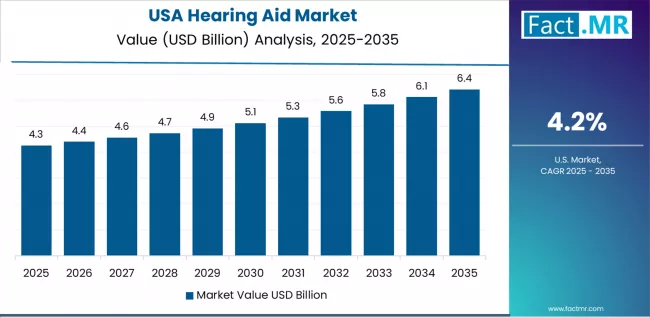
The U.S. market leads in comprehensive hearing aid innovation based on integration with healthcare systems and established professional audiology networks for enhanced service delivery performance. The country shows strong potential with a CAGR of 4.2% through 2035, driven by the expansion of over-the-counter regulations and Medicare Advantage coverage expansion in major demographic areas, including Florida, California, Arizona, and Texas. American consumers are adopting advanced hearing technologies for quality enhancement and accessibility improvement, particularly in regions with established retirement communities and healthcare integration demanding comprehensive hearing care coordination. Service delivery channels through established audiology practices and retail networks expand coverage across senior communities and healthcare-focused demographics.
Leading market segments:
- Senior population care and Medicare beneficiaries are driving comprehensive hearing aid service expansion
- Healthcare system partnerships with hearing providers, achieving 85% user satisfaction improvement rates
- Strategic collaborations between insurance companies and hearing care providers are expanding market presence
- Focus on technology advancement and specialized hearing care requirements
South Korea Shows Technology Integration Growth
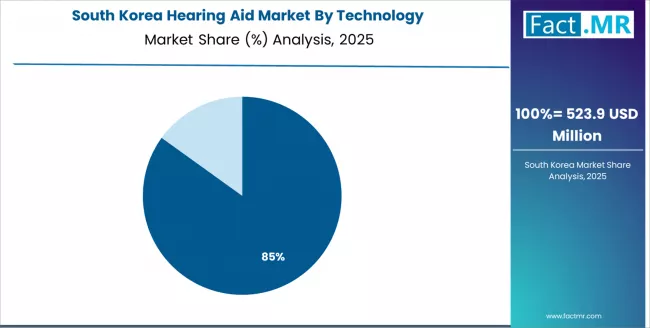
In Seoul, Busan, Daegu, and Incheon, consumers are implementing comprehensive hearing aid solutions to integrate with digital health platforms and smartphone connectivity, with documented case studies showing 40% improvement in communication satisfaction through advanced hearing technologies. The market shows strong growth potential with a CAGR of 3.7% through 2035, linked to ongoing digital health expansion, technology integration initiatives, and emerging connected healthcare projects in major regions. Korean consumers are adopting intelligent hearing systems and connectivity platforms to enhance communication quality while maintaining technology integration and digital lifestyle coordination. The country's established technology infrastructure creates demand for advanced hearing solutions that integrate with existing digital health and communication systems.
Market development factors:
- Technology-savvy consumers and digital health facilities leading hearing aid adoption with comprehensive connectivity integration
- Digital health modernization programs providing government support for healthcare technology and connectivity infrastructure development
- Strategic partnerships between Korean technology companies and international hearing providers are expanding technical capabilities
- Emphasis on digital integration and connectivity standards across healthcare applications
Germany Emphasizes Quality Care Standards
Germany's hearing aid market demonstrates sophisticated implementation focused on professional service quality and insurance integration, with documented integration of advanced hearing solutions achieving 30% improvement in user satisfaction across audiology practices and healthcare facilities. The country maintains steady growth momentum with a CAGR of 3.4% through 2035, driven by healthcare facilities' emphasis on quality standards and professional service methodologies that align with German healthcare system requirements applied to hearing care operations. Major population centers, including Berlin, Munich, Hamburg, and Frankfurt, showcase advanced deployment of hearing technologies where professional services integrate seamlessly with existing healthcare insurance coverage and comprehensive care management programs.
Key market characteristics:
- Professional audiology practices and healthcare facilities are driving advanced hearing aid requirements with emphasis on quality assurance and professional fitting
- Insurance integration partnerships enabling 94% coverage compliance with comprehensive hearing care programs
- International collaboration between German healthcare providers and hearing technology companies is expanding market capabilities
- Emphasis on professional standards and quality care methodologies
Japan Emphasizes Advanced Technology Integration
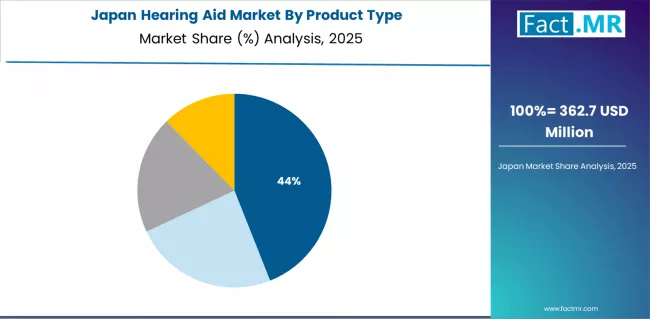
Japan's Hearing Aid Market demonstrates mature and technology-integrated landscape, characterized by sophisticated coordination of hearing solutions with existing healthcare infrastructure across aging population centers, healthcare facilities, and technology integration networks. Japan's emphasis on aging population support and technological innovation drives demand for high-quality hearing solutions that support comprehensive elderly care initiatives and technology coordination requirements in hearing care operations. The market benefits from strong partnerships between international hearing providers and domestic healthcare organizations, creating comprehensive care ecosystems that prioritize technology integration and professional service excellence programs. Urban areas in major population centers showcase advanced hearing implementations where technology solutions achieve 88% user satisfaction through integrated digital health programs.
In Japan, digital hearing aids dominate with 88.1% market share, while analog devices maintain 11.9%, reflecting the country's preference for advanced technology solutions and sophisticated processing capabilities in hearing healthcare delivery.
In South Korea, audiology & ENT clinics lead distribution with 61.5% market share, followed by retail chains/pharmacies at 23.4% and online/DTC at 15.1%, demonstrating the continued importance of professional service delivery in technology adoption.
Europe Market Split by Country
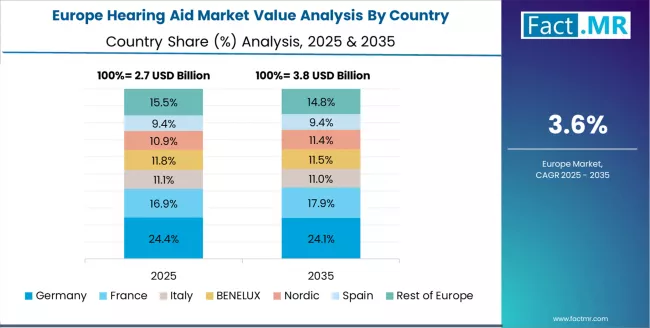
The hearing aid market in Europe is projected to grow steadily, with Germany maintaining its leadership position with a 24.7% market share in 2025, supported by its extensive healthcare infrastructure, advanced audiology facilities, and comprehensive hearing aid reimbursement networks serving major European markets.
United Kingdom follows with a 15.7% share in 2025, driven by NHS hearing services and private healthcare expansion in major regions implementing comprehensive hearing care programs. France holds a 14.8% share through ongoing development of healthcare facilities and audiology networks. Italy commands a 12.5% share, while Spain accounts for 9.9% in 2025. The Rest of Europe region represents 22.4% of the market, attributed to hearing aid adoption across Nordic countries and emerging Eastern European healthcare facilities implementing modern audiology programs.
Competitive Landscape of the Hearing Aid Market
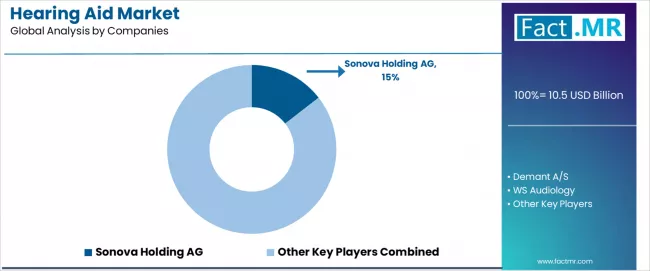
The Hearing Aid Market features approximately 40-50 meaningful players with moderate concentration, where the top three companies control roughly 35-42% of global market share through established hearing device portfolios and extensive audiological relationships. Competition centers on sound quality, user experience, and technology innovation rather than price competition alone.
Market leaders include Sonova Holding AG with 14.5% market share, along with Demant A/S, WS Audiology, and GN Store Nord (GN Hearing), which maintain competitive advantages through comprehensive hearing solution portfolios, global distribution networks, and deep expertise in the audiology and hearing healthcare sectors, creating high switching costs for customers. These companies leverage established audiologist relationships and ongoing patient support services to defend market positions while expanding into adjacent hearing health and direct-consumer applications.
Challengers encompass Starkey Hearing Technologies and specialized companies including Cochlear Ltd. (implantable solutions), which compete through specialized hearing technologies and strong regional presence in key demographics. Technology specialists, including MED-EL, Eargo, and regional players like Rion Co. Ltd. (Japan) and Arphi Electronics (India), focus on specific technologies or geographic markets, offering differentiated capabilities in implantable devices, direct-consumer solutions, and regional market expertise.
Distribution specialists including Amplifon create competitive pressure through extensive retail networks and professional service integration, while emerging companies like Zounds Hearing, Hansaton, and NewSound Hearing focus on innovative approaches to consumer accessibility and technology development.
Global Hearing Aid Market - Stakeholder Contribution Framework
Hearing aid solutions represent a critical healthcare technology that enables individuals, families, and healthcare systems to address hearing loss effectively while maintaining communication abilities and quality of life without substantial social limitations. With the market projected to grow from USD 10,540.7 million in 2025 to USD 16,220.5 million by 2035 at a 4.4% CAGR, these solutions offer compelling advantages including improved communication, enhanced social engagement, and cognitive health support, making them essential for aging populations (growing segment), hearing loss management (expanding adoption), and diverse applications seeking reliable hearing enhancement solutions. Scaling market penetration and technology capabilities requires coordinated action across healthcare policy, audiology standards, device manufacturers, technology providers, and professional service institutions.
How Governments Could Spur Local Production and Adoption?
- Healthcare Infrastructure Programs: Include hearing healthcare capabilities in national aging population initiatives, providing targeted funding for audiology services in underserved regions and supporting hearing aid accessibility through insurance coverage expansion and professional training support.
- Tax Policy & R&D Support: Implement accelerated depreciation schedules for hearing aid technologies, provide tax incentives for companies investing in digital processing and wireless connectivity development, and establish favorable research accounting standards that encourage advanced hearing solution adoption over basic amplification approaches.
- Regulatory Framework Development: Create streamlined device approval processes across professional and over-the-counter applications, establish clear quality testing frameworks for hearing aid operation, and develop insurance coverage protocols that facilitate accessible hearing healthcare across diverse population segments.
- Skills Development & Training: Fund audiology programs for hearing healthcare professionals, device specialists, and support staff. Invest in technology transfer initiatives that bridge academic research with commercial device development and professional service optimization systems.
- Market Access & Competition: Establish insurance policies that cover hearing aids for qualified individuals, support audiology practice development through professional lending programs, and create regulatory environments that encourage innovation in hearing technologies and service delivery models.
How Industry Bodies Could Support Market Development?
- Quality Standards & Certification: Define standardized performance metrics for hearing aid technologies across professional fitting and consumer applications, establish universal quality and safety protocols, and create certification programs for device performance that consumers and professionals can rely upon.
- Market Education & Best Practices: Lead messaging that demonstrates hearing aid advantages, emphasizing improved quality of life, enhanced communication capabilities, and social engagement benefits compared to untreated hearing loss.
- Technology Integration Standards: Develop interoperability standards for hearing aid systems, smartphone compatibility guidelines, and telehealth platforms, ensuring seamless integration across different technology environments and user requirements.
- Professional Development: Run certification programs for audiologists, hearing aid specialists, and support staff on optimizing device performance, patient care coordination, and outcome measurement in competitive hearing healthcare markets.
How Manufacturers and Technology Players Could Strengthen the Ecosystem?
- Advanced Device Development: Develop next-generation hearing aids with enhanced digital processing capabilities, improved wireless connectivity, and application-specific features that enhance communication reliability while reducing size and power consumption.
- Intelligence Platforms: Provide comprehensive fitting software that integrates hearing assessment, device programming, outcome tracking, and remote adjustment capabilities, enabling professionals to maximize device effectiveness and patient satisfaction.
- Service & Support Networks: Offer flexible support programs for audiology practices and healthcare facilities, including professional training options, technical support services, and outcome optimization pathways that keep hearing technologies current with patient needs.
- Research & Development Networks: Build comprehensive R&D capabilities, collaborative innovation programs, and specialized application development that ensure hearing technologies maintain high performance standards and consistent outcomes across diverse hearing loss patterns and user environments.
How Service Providers Could Navigate Technology Evolution?
- Diversified Device Portfolios: Expand hearing aid offerings across BTE devices (43.6% market dominance), ITE solutions (29.5% share), and RIC/RITE technologies (21.7% share), with particular focus on digital systems (83.2% market leadership) and specialized solutions for individual hearing requirements.
- Geographic Market Development: Establish services in high-growth markets like India (6.0% CAGR) and China (5.4% CAGR), while strengthening presence in established markets like Brazil (4.6% CAGR) and United States (4.2% CAGR) through professional service capabilities and technology partnerships.
- Technology-Enabled Services: Implement advanced fitting systems with real-time hearing assessment, remote adjustment capabilities, and outcome tracking features that differentiate service offerings and improve patient satisfaction and retention.
- Flexible Service Models: Develop professional, retail, and online service solutions that accommodate varying consumer needs, from comprehensive audiological care to convenient access for basic hearing enhancement applications.
How Investors and Financial Enablers Could Unlock Value?
- Technology Expansion Financing: Provide growth capital for established companies like Sonova, Demant, and WS Audiology to expand device development capacity and geographic coverage, particularly in emerging markets with growing aging population demands.
- Innovation Investment: Back startups developing AI-powered hearing aids, wireless connectivity platforms, and direct-consumer solutions that enhance hearing healthcare accessibility and user experience.
- Regional Market Development: Finance market entry and expansion strategies for hearing companies establishing operations in high-growth regions, supporting localization initiatives that reduce device costs while maintaining performance standards.
- Consolidation & Scale Opportunities: Support strategic acquisitions and market consolidation that create technology efficiencies, improve device capabilities, and enhance competitive positioning against fragmented regional providers across multiple geographic markets.
Key Players in the Hearing Aid Market
- Sonova Holding AG
- Demant A/S
- WS Audiology
- GN Store Nord (GN Hearing)
- Starkey Hearing Technologies
- Cochlear Ltd.
- MED-EL
- Amplifon
- Eargo
- Audina Hearing Instruments
- Rion Co. Ltd.
- Zounds Hearing
- Arphi Electronics
- Hansaton
- NewSound Hearing
Scope of the Report
| Items | Values |
|---|---|
| Quantitative Units | USD 10,540.7 Million |
| Product Type | Behind-the-Ear (BTE), In-the-Ear (ITE), Receiver-in-Canal (RIC)/Receiver-in-Ear (RITE), Others |
| Technology | Digital Hearing Aids, Analog Hearing Aids |
| Distribution Channel | Audiology & ENT Clinics, Retail Chains/Pharmacies, Online/DTC |
| Regions Covered | North America, Europe, Asia Pacific, Rest of World |
| Country Covered | India, China, Brazil, USA, South Korea, Germany, Japan, and 40+ countries |
| Key Companies Profiled | Sonova Holding AG, Demant A/S, WS Audiology, GN Store Nord (GN Hearing), Starkey Hearing Technologies, Cochlear Ltd., MED-EL, Amplifon, Eargo, Audina Hearing Instruments, Rion Co. Ltd., Zounds Hearing, Arphi Electronics, Hansaton, NewSound Hearing |
| Additional Attributes | Dollar sales by product type and technology categories, regional adoption trends across North America, Europe, and Asia Pacific, competitive landscape with hearing solution providers and healthcare companies, audiology facility requirements and specifications, integration with healthcare systems and smartphone platforms, innovations in digital processing technology and connectivity systems, and development of specialized applications with hearing enhancement accuracy and user satisfaction capabilities. |
Hearing Aid Market by Segments
-
Product Type :
- Behind-the-Ear (BTE)
- In-the-Ear (ITE)
- Receiver-in-Canal (RIC)/Receiver-in-Ear (RITE)
- Others (Bone Anchored, etc.)
-
Technology :
- Digital Hearing Aids
- Analog Hearing Aids
-
Distribution Channel :
- Audiology & ENT Clinics
- Retail Chains/Pharmacies
- Online/DTC
-
Region :
- North America
- United States
- Canada
- Mexico
- Europe
- Germany
- United Kingdom
- France
- Italy
- Spain
- Nordic
- BENELUX
- Rest of Europe
- Asia Pacific
- China
- Japan
- South Korea
- India
- Australia & New Zealand
- ASEAN
- Rest of Asia Pacific
- Rest of World
- Brazil
- Chile
- Rest of Latin America
- Kingdom of Saudi Arabia
- Other GCC Countries
- Turkey
- South Africa
- Other African Union
- Rest of Middle East & Africa
- North America
Table of Content
- Executive Summary
- Global Market Outlook
- Demand to side Trends
- Supply to side Trends
- Technology Roadmap Analysis
- Analysis and Recommendations
- Market Overview
- Market Coverage / Taxonomy
- Market Definition / Scope / Limitations
- Market Background
- Market Dynamics
- Drivers
- Restraints
- Opportunity
- Trends
- Scenario Forecast
- Demand in Optimistic Scenario
- Demand in Likely Scenario
- Demand in Conservative Scenario
- Opportunity Map Analysis
- Product Life Cycle Analysis
- Supply Chain Analysis
- Investment Feasibility Matrix
- Value Chain Analysis
- PESTLE and Porter’s Analysis
- Regulatory Landscape
- Regional Parent Market Outlook
- Production and Consumption Statistics
- Import and Export Statistics
- Market Dynamics
- Global Market Analysis 2020 to 2024 and Forecast, 2025 to 2035
- Historical Market Size Value (USD Million) Analysis, 2020 to 2024
- Current and Future Market Size Value (USD Million) Projections, 2025 to 2035
- Y to o to Y Growth Trend Analysis
- Absolute $ Opportunity Analysis
- Global Market Pricing Analysis 2020 to 2024 and Forecast 2025 to 2035
- Global Market Analysis 2020 to 2024 and Forecast 2025 to 2035, By Product Type
- Introduction / Key Findings
- Historical Market Size Value (USD Million) Analysis By Product Type , 2020 to 2024
- Current and Future Market Size Value (USD Million) Analysis and Forecast By Product Type , 2025 to 2035
- Behind-the-Ear (BTE)
- In-the-Ear (ITE)
- Receiver-in-Canal (RIC)/Receiver-in-Ear (RITE)
- Others (Bone Anchored, etc.)
- Y to o to Y Growth Trend Analysis By Product Type , 2020 to 2024
- Absolute $ Opportunity Analysis By Product Type , 2025 to 2035
- Global Market Analysis 2020 to 2024 and Forecast 2025 to 2035, By Technology
- Introduction / Key Findings
- Historical Market Size Value (USD Million) Analysis By Technology, 2020 to 2024
- Current and Future Market Size Value (USD Million) Analysis and Forecast By Technology, 2025 to 2035
- Digital Hearing Aids
- Analog Hearing Aids
- Y to o to Y Growth Trend Analysis By Technology, 2020 to 2024
- Absolute $ Opportunity Analysis By Technology, 2025 to 2035
- Global Market Analysis 2020 to 2024 and Forecast 2025 to 2035, By Distribution Channel
- Introduction / Key Findings
- Historical Market Size Value (USD Million) Analysis By Distribution Channel, 2020 to 2024
- Current and Future Market Size Value (USD Million) Analysis and Forecast By Distribution Channel, 2025 to 2035
- Audiology & ENT Clinics
- Retail Chains/Pharmacies
- Online/DTC
- Y to o to Y Growth Trend Analysis By Distribution Channel, 2020 to 2024
- Absolute $ Opportunity Analysis By Distribution Channel, 2025 to 2035
- Global Market Analysis 2020 to 2024 and Forecast 2025 to 2035, By Region
- Introduction
- Historical Market Size Value (USD Million) Analysis By Region, 2020 to 2024
- Current Market Size Value (USD Million) Analysis and Forecast By Region, 2025 to 2035
- North America
- Latin America
- Western Europe
- Eastern Europe
- East Asia
- South Asia and Pacific
- Middle East & Africa
- Market Attractiveness Analysis By Region
- North America Market Analysis 2020 to 2024 and Forecast 2025 to 2035, By Country
- Historical Market Size Value (USD Million) Trend Analysis By Market Taxonomy, 2020 to 2024
- Market Size Value (USD Million) Forecast By Market Taxonomy, 2025 to 2035
- By Country
- USA
- Canada
- Mexico
- By Product Type
- By Technology
- By Distribution Channel
- By Country
- Market Attractiveness Analysis
- By Country
- By Product Type
- By Technology
- By Distribution Channel
- Key Takeaways
- Latin America Market Analysis 2020 to 2024 and Forecast 2025 to 2035, By Country
- Historical Market Size Value (USD Million) Trend Analysis By Market Taxonomy, 2020 to 2024
- Market Size Value (USD Million) Forecast By Market Taxonomy, 2025 to 2035
- By Country
- Brazil
- Chile
- Rest of Latin America
- By Product Type
- By Technology
- By Distribution Channel
- By Country
- Market Attractiveness Analysis
- By Country
- By Product Type
- By Technology
- By Distribution Channel
- Key Takeaways
- Western Europe Market Analysis 2020 to 2024 and Forecast 2025 to 2035, By Country
- Historical Market Size Value (USD Million) Trend Analysis By Market Taxonomy, 2020 to 2024
- Market Size Value (USD Million) Forecast By Market Taxonomy, 2025 to 2035
- By Country
- Germany
- UK
- Italy
- Spain
- France
- Nordic
- BENELUX
- Rest of Western Europe
- By Product Type
- By Technology
- By Distribution Channel
- By Country
- Market Attractiveness Analysis
- By Country
- By Product Type
- By Technology
- By Distribution Channel
- Key Takeaways
- Eastern Europe Market Analysis 2020 to 2024 and Forecast 2025 to 2035, By Country
- Historical Market Size Value (USD Million) Trend Analysis By Market Taxonomy, 2020 to 2024
- Market Size Value (USD Million) Forecast By Market Taxonomy, 2025 to 2035
- By Country
- Russia
- Poland
- Hungary
- Balkan & Baltic
- Rest of Eastern Europe
- By Product Type
- By Technology
- By Distribution Channel
- By Country
- Market Attractiveness Analysis
- By Country
- By Product Type
- By Technology
- By Distribution Channel
- Key Takeaways
- East Asia Market Analysis 2020 to 2024 and Forecast 2025 to 2035, By Country
- Historical Market Size Value (USD Million) Trend Analysis By Market Taxonomy, 2020 to 2024
- Market Size Value (USD Million) Forecast By Market Taxonomy, 2025 to 2035
- By Country
- China
- Japan
- South Korea
- By Product Type
- By Technology
- By Distribution Channel
- By Country
- Market Attractiveness Analysis
- By Country
- By Product Type
- By Technology
- By Distribution Channel
- Key Takeaways
- South Asia and Pacific Market Analysis 2020 to 2024 and Forecast 2025 to 2035, By Country
- Historical Market Size Value (USD Million) Trend Analysis By Market Taxonomy, 2020 to 2024
- Market Size Value (USD Million) Forecast By Market Taxonomy, 2025 to 2035
- By Country
- India
- ASEAN
- Australia & New Zealand
- Rest of South Asia and Pacific
- By Product Type
- By Technology
- By Distribution Channel
- By Country
- Market Attractiveness Analysis
- By Country
- By Product Type
- By Technology
- By Distribution Channel
- Key Takeaways
- Middle East & Africa Market Analysis 2020 to 2024 and Forecast 2025 to 2035, By Country
- Historical Market Size Value (USD Million) Trend Analysis By Market Taxonomy, 2020 to 2024
- Market Size Value (USD Million) Forecast By Market Taxonomy, 2025 to 2035
- By Country
- Kingdom of Saudi Arabia
- Other GCC Countries
- Turkiye
- South Africa
- Other African Union
- Rest of Middle East & Africa
- By Product Type
- By Technology
- By Distribution Channel
- By Country
- Market Attractiveness Analysis
- By Country
- By Product Type
- By Technology
- By Distribution Channel
- Key Takeaways
- Key Countries Market Analysis
- USA
- Pricing Analysis
- Market Share Analysis, 2024
- By Product Type
- By Technology
- By Distribution Channel
- Canada
- Pricing Analysis
- Market Share Analysis, 2024
- By Product Type
- By Technology
- By Distribution Channel
- Mexico
- Pricing Analysis
- Market Share Analysis, 2024
- By Product Type
- By Technology
- By Distribution Channel
- Brazil
- Pricing Analysis
- Market Share Analysis, 2024
- By Product Type
- By Technology
- By Distribution Channel
- Chile
- Pricing Analysis
- Market Share Analysis, 2024
- By Product Type
- By Technology
- By Distribution Channel
- Germany
- Pricing Analysis
- Market Share Analysis, 2024
- By Product Type
- By Technology
- By Distribution Channel
- UK
- Pricing Analysis
- Market Share Analysis, 2024
- By Product Type
- By Technology
- By Distribution Channel
- Italy
- Pricing Analysis
- Market Share Analysis, 2024
- By Product Type
- By Technology
- By Distribution Channel
- Spain
- Pricing Analysis
- Market Share Analysis, 2024
- By Product Type
- By Technology
- By Distribution Channel
- France
- Pricing Analysis
- Market Share Analysis, 2024
- By Product Type
- By Technology
- By Distribution Channel
- India
- Pricing Analysis
- Market Share Analysis, 2024
- By Product Type
- By Technology
- By Distribution Channel
- ASEAN
- Pricing Analysis
- Market Share Analysis, 2024
- By Product Type
- By Technology
- By Distribution Channel
- Australia & New Zealand
- Pricing Analysis
- Market Share Analysis, 2024
- By Product Type
- By Technology
- By Distribution Channel
- China
- Pricing Analysis
- Market Share Analysis, 2024
- By Product Type
- By Technology
- By Distribution Channel
- Japan
- Pricing Analysis
- Market Share Analysis, 2024
- By Product Type
- By Technology
- By Distribution Channel
- South Korea
- Pricing Analysis
- Market Share Analysis, 2024
- By Product Type
- By Technology
- By Distribution Channel
- Russia
- Pricing Analysis
- Market Share Analysis, 2024
- By Product Type
- By Technology
- By Distribution Channel
- Poland
- Pricing Analysis
- Market Share Analysis, 2024
- By Product Type
- By Technology
- By Distribution Channel
- Hungary
- Pricing Analysis
- Market Share Analysis, 2024
- By Product Type
- By Technology
- By Distribution Channel
- Kingdom of Saudi Arabia
- Pricing Analysis
- Market Share Analysis, 2024
- By Product Type
- By Technology
- By Distribution Channel
- Turkiye
- Pricing Analysis
- Market Share Analysis, 2024
- By Product Type
- By Technology
- By Distribution Channel
- South Africa
- Pricing Analysis
- Market Share Analysis, 2024
- By Product Type
- By Technology
- By Distribution Channel
- USA
- Market Structure Analysis
- Competition Dashboard
- Competition Benchmarking
- Market Share Analysis of Top Players
- By Regional
- By Product Type
- By Technology
- By Distribution Channel
- Competition Analysis
- Competition Deep Dive
- Sonova Holding AG
- Overview
- Product Portfolio
- Profitability by Market Segments (Product/Age /Sales Channel/Region)
- Sales Footprint
- Strategy Overview
- Marketing Strategy
- Product Strategy
- Channel Strategy
- Demant A/S
- WS Audiology
- GN Store Nord (GN Hearing)
- Starkey Hearing Technologies
- Cochlear Ltd.
- MED-EL
- Amplifon
- Eargo
- Audina Hearing Instruments
- Rion Co. Ltd.
- Zounds Hearing
- Arphi Electronics
- Hansaton
- NewSound Hearing
- Sonova Holding AG
- Competition Deep Dive
- Assumptions & Acronyms Used
- Research Methodology
List Of Table
- Table 1: Global Market Value (USD Million) Forecast by Region, 2020 to 2035
- Table 2: Global Market Value (USD Million) Forecast by Product Type , 2020 to 2035
- Table 3: Global Market Value (USD Million) Forecast by Technology, 2020 to 2035
- Table 4: Global Market Value (USD Million) Forecast by Distribution Channel, 2020 to 2035
- Table 5: North America Market Value (USD Million) Forecast by Country, 2020 to 2035
- Table 6: North America Market Value (USD Million) Forecast by Product Type , 2020 to 2035
- Table 7: North America Market Value (USD Million) Forecast by Technology, 2020 to 2035
- Table 8: North America Market Value (USD Million) Forecast by Distribution Channel, 2020 to 2035
- Table 9: Latin America Market Value (USD Million) Forecast by Country, 2020 to 2035
- Table 10: Latin America Market Value (USD Million) Forecast by Product Type , 2020 to 2035
- Table 11: Latin America Market Value (USD Million) Forecast by Technology, 2020 to 2035
- Table 12: Latin America Market Value (USD Million) Forecast by Distribution Channel, 2020 to 2035
- Table 13: Western Europe Market Value (USD Million) Forecast by Country, 2020 to 2035
- Table 14: Western Europe Market Value (USD Million) Forecast by Product Type , 2020 to 2035
- Table 15: Western Europe Market Value (USD Million) Forecast by Technology, 2020 to 2035
- Table 16: Western Europe Market Value (USD Million) Forecast by Distribution Channel, 2020 to 2035
- Table 17: Eastern Europe Market Value (USD Million) Forecast by Country, 2020 to 2035
- Table 18: Eastern Europe Market Value (USD Million) Forecast by Product Type , 2020 to 2035
- Table 19: Eastern Europe Market Value (USD Million) Forecast by Technology, 2020 to 2035
- Table 20: Eastern Europe Market Value (USD Million) Forecast by Distribution Channel, 2020 to 2035
- Table 21: East Asia Market Value (USD Million) Forecast by Country, 2020 to 2035
- Table 22: East Asia Market Value (USD Million) Forecast by Product Type , 2020 to 2035
- Table 23: East Asia Market Value (USD Million) Forecast by Technology, 2020 to 2035
- Table 24: East Asia Market Value (USD Million) Forecast by Distribution Channel, 2020 to 2035
- Table 25: South Asia and Pacific Market Value (USD Million) Forecast by Country, 2020 to 2035
- Table 26: South Asia and Pacific Market Value (USD Million) Forecast by Product Type , 2020 to 2035
- Table 27: South Asia and Pacific Market Value (USD Million) Forecast by Technology, 2020 to 2035
- Table 28: South Asia and Pacific Market Value (USD Million) Forecast by Distribution Channel, 2020 to 2035
- Table 29: Middle East & Africa Market Value (USD Million) Forecast by Country, 2020 to 2035
- Table 30: Middle East & Africa Market Value (USD Million) Forecast by Product Type , 2020 to 2035
- Table 31: Middle East & Africa Market Value (USD Million) Forecast by Technology, 2020 to 2035
- Table 32: Middle East & Africa Market Value (USD Million) Forecast by Distribution Channel, 2020 to 2035
List Of Figures
- Figure 1: Global Market Pricing Analysis
- Figure 2: Global Market Value (USD Million) Forecast 2020-2035
- Figure 3: Global Market Value Share and BPS Analysis by Product Type , 2025 and 2035
- Figure 4: Global Market Y to o to Y Growth Comparison by Product Type , 2025-2035
- Figure 5: Global Market Attractiveness Analysis by Product Type
- Figure 6: Global Market Value Share and BPS Analysis by Technology, 2025 and 2035
- Figure 7: Global Market Y to o to Y Growth Comparison by Technology, 2025-2035
- Figure 8: Global Market Attractiveness Analysis by Technology
- Figure 9: Global Market Value Share and BPS Analysis by Distribution Channel, 2025 and 2035
- Figure 10: Global Market Y to o to Y Growth Comparison by Distribution Channel, 2025-2035
- Figure 11: Global Market Attractiveness Analysis by Distribution Channel
- Figure 12: Global Market Value (USD Million) Share and BPS Analysis by Region, 2025 and 2035
- Figure 13: Global Market Y to o to Y Growth Comparison by Region, 2025-2035
- Figure 14: Global Market Attractiveness Analysis by Region
- Figure 15: North America Market Incremental Dollar Opportunity, 2025-2035
- Figure 16: Latin America Market Incremental Dollar Opportunity, 2025-2035
- Figure 17: Western Europe Market Incremental Dollar Opportunity, 2025-2035
- Figure 18: Eastern Europe Market Incremental Dollar Opportunity, 2025-2035
- Figure 19: East Asia Market Incremental Dollar Opportunity, 2025-2035
- Figure 20: South Asia and Pacific Market Incremental Dollar Opportunity, 2025-2035
- Figure 21: Middle East & Africa Market Incremental Dollar Opportunity, 2025-2035
- Figure 22: North America Market Value Share and BPS Analysis by Country, 2025 and 2035
- Figure 23: North America Market Value Share and BPS Analysis by Product Type , 2025 and 2035
- Figure 24: North America Market Y to o to Y Growth Comparison by Product Type , 2025-2035
- Figure 25: North America Market Attractiveness Analysis by Product Type
- Figure 26: North America Market Value Share and BPS Analysis by Technology, 2025 and 2035
- Figure 27: North America Market Y to o to Y Growth Comparison by Technology, 2025-2035
- Figure 28: North America Market Attractiveness Analysis by Technology
- Figure 29: North America Market Value Share and BPS Analysis by Distribution Channel, 2025 and 2035
- Figure 30: North America Market Y to o to Y Growth Comparison by Distribution Channel, 2025-2035
- Figure 31: North America Market Attractiveness Analysis by Distribution Channel
- Figure 32: Latin America Market Value Share and BPS Analysis by Country, 2025 and 2035
- Figure 33: Latin America Market Value Share and BPS Analysis by Product Type , 2025 and 2035
- Figure 34: Latin America Market Y to o to Y Growth Comparison by Product Type , 2025-2035
- Figure 35: Latin America Market Attractiveness Analysis by Product Type
- Figure 36: Latin America Market Value Share and BPS Analysis by Technology, 2025 and 2035
- Figure 37: Latin America Market Y to o to Y Growth Comparison by Technology, 2025-2035
- Figure 38: Latin America Market Attractiveness Analysis by Technology
- Figure 39: Latin America Market Value Share and BPS Analysis by Distribution Channel, 2025 and 2035
- Figure 40: Latin America Market Y to o to Y Growth Comparison by Distribution Channel, 2025-2035
- Figure 41: Latin America Market Attractiveness Analysis by Distribution Channel
- Figure 42: Western Europe Market Value Share and BPS Analysis by Country, 2025 and 2035
- Figure 43: Western Europe Market Value Share and BPS Analysis by Product Type , 2025 and 2035
- Figure 44: Western Europe Market Y to o to Y Growth Comparison by Product Type , 2025-2035
- Figure 45: Western Europe Market Attractiveness Analysis by Product Type
- Figure 46: Western Europe Market Value Share and BPS Analysis by Technology, 2025 and 2035
- Figure 47: Western Europe Market Y to o to Y Growth Comparison by Technology, 2025-2035
- Figure 48: Western Europe Market Attractiveness Analysis by Technology
- Figure 49: Western Europe Market Value Share and BPS Analysis by Distribution Channel, 2025 and 2035
- Figure 50: Western Europe Market Y to o to Y Growth Comparison by Distribution Channel, 2025-2035
- Figure 51: Western Europe Market Attractiveness Analysis by Distribution Channel
- Figure 52: Eastern Europe Market Value Share and BPS Analysis by Country, 2025 and 2035
- Figure 53: Eastern Europe Market Value Share and BPS Analysis by Product Type , 2025 and 2035
- Figure 54: Eastern Europe Market Y to o to Y Growth Comparison by Product Type , 2025-2035
- Figure 55: Eastern Europe Market Attractiveness Analysis by Product Type
- Figure 56: Eastern Europe Market Value Share and BPS Analysis by Technology, 2025 and 2035
- Figure 57: Eastern Europe Market Y to o to Y Growth Comparison by Technology, 2025-2035
- Figure 58: Eastern Europe Market Attractiveness Analysis by Technology
- Figure 59: Eastern Europe Market Value Share and BPS Analysis by Distribution Channel, 2025 and 2035
- Figure 60: Eastern Europe Market Y to o to Y Growth Comparison by Distribution Channel, 2025-2035
- Figure 61: Eastern Europe Market Attractiveness Analysis by Distribution Channel
- Figure 62: East Asia Market Value Share and BPS Analysis by Country, 2025 and 2035
- Figure 63: East Asia Market Value Share and BPS Analysis by Product Type , 2025 and 2035
- Figure 64: East Asia Market Y to o to Y Growth Comparison by Product Type , 2025-2035
- Figure 65: East Asia Market Attractiveness Analysis by Product Type
- Figure 66: East Asia Market Value Share and BPS Analysis by Technology, 2025 and 2035
- Figure 67: East Asia Market Y to o to Y Growth Comparison by Technology, 2025-2035
- Figure 68: East Asia Market Attractiveness Analysis by Technology
- Figure 69: East Asia Market Value Share and BPS Analysis by Distribution Channel, 2025 and 2035
- Figure 70: East Asia Market Y to o to Y Growth Comparison by Distribution Channel, 2025-2035
- Figure 71: East Asia Market Attractiveness Analysis by Distribution Channel
- Figure 72: South Asia and Pacific Market Value Share and BPS Analysis by Country, 2025 and 2035
- Figure 73: South Asia and Pacific Market Value Share and BPS Analysis by Product Type , 2025 and 2035
- Figure 74: South Asia and Pacific Market Y to o to Y Growth Comparison by Product Type , 2025-2035
- Figure 75: South Asia and Pacific Market Attractiveness Analysis by Product Type
- Figure 76: South Asia and Pacific Market Value Share and BPS Analysis by Technology, 2025 and 2035
- Figure 77: South Asia and Pacific Market Y to o to Y Growth Comparison by Technology, 2025-2035
- Figure 78: South Asia and Pacific Market Attractiveness Analysis by Technology
- Figure 79: South Asia and Pacific Market Value Share and BPS Analysis by Distribution Channel, 2025 and 2035
- Figure 80: South Asia and Pacific Market Y to o to Y Growth Comparison by Distribution Channel, 2025-2035
- Figure 81: South Asia and Pacific Market Attractiveness Analysis by Distribution Channel
- Figure 82: Middle East & Africa Market Value Share and BPS Analysis by Country, 2025 and 2035
- Figure 83: Middle East & Africa Market Value Share and BPS Analysis by Product Type , 2025 and 2035
- Figure 84: Middle East & Africa Market Y to o to Y Growth Comparison by Product Type , 2025-2035
- Figure 85: Middle East & Africa Market Attractiveness Analysis by Product Type
- Figure 86: Middle East & Africa Market Value Share and BPS Analysis by Technology, 2025 and 2035
- Figure 87: Middle East & Africa Market Y to o to Y Growth Comparison by Technology, 2025-2035
- Figure 88: Middle East & Africa Market Attractiveness Analysis by Technology
- Figure 89: Middle East & Africa Market Value Share and BPS Analysis by Distribution Channel, 2025 and 2035
- Figure 90: Middle East & Africa Market Y to o to Y Growth Comparison by Distribution Channel, 2025-2035
- Figure 91: Middle East & Africa Market Attractiveness Analysis by Distribution Channel
- Figure 92: Global Market - Tier Structure Analysis
- Figure 93: Global Market - Company Share Analysis
- FAQs -
How big is the hearing aid market in 2025?
The global hearing aid market is estimated to be valued at USD 10,540.7 million in 2025.
What will be the size of hearing aid market in 2035?
The market size for the hearing aid market is projected to reach USD 16,213.4 million by 2035.
How much will be the hearing aid market growth between 2025 and 2035?
The hearing aid market is expected to grow at a 4.4% CAGR between 2025 and 2035.
What are the key product types in the hearing aid market?
The key product types in hearing aid market are behind-the-ear (bte), in-the-ear (ite), receiver-in-canal (ric)/receiver-in-ear (rite) and others (bone anchored, etc.).
Which technology segment to contribute significant share in the hearing aid market in 2025?
In terms of technology, digital hearing aids segment to command 83.2% share in the hearing aid market in 2025.